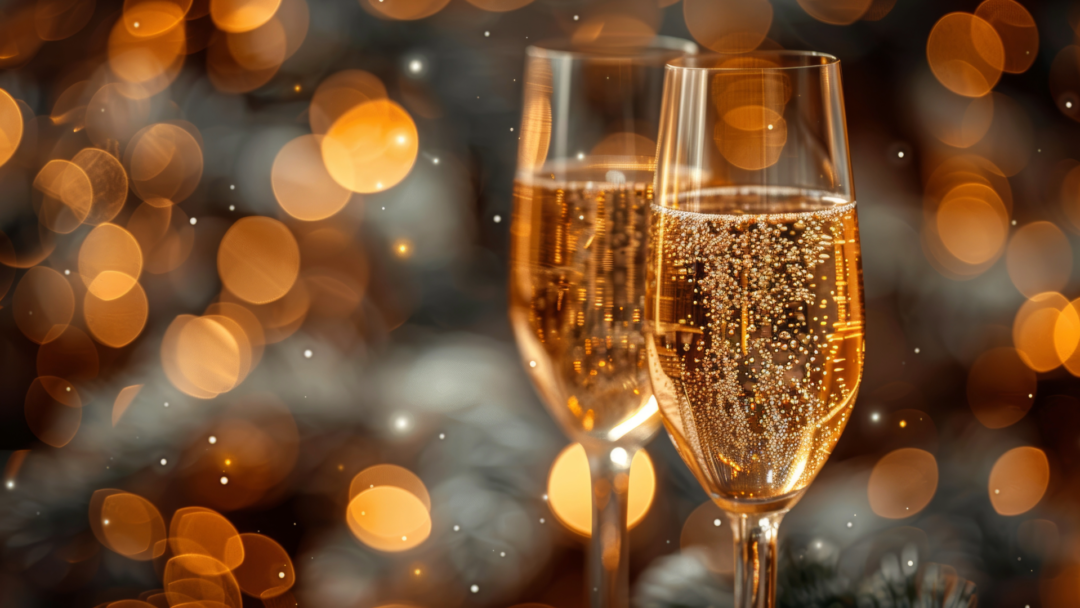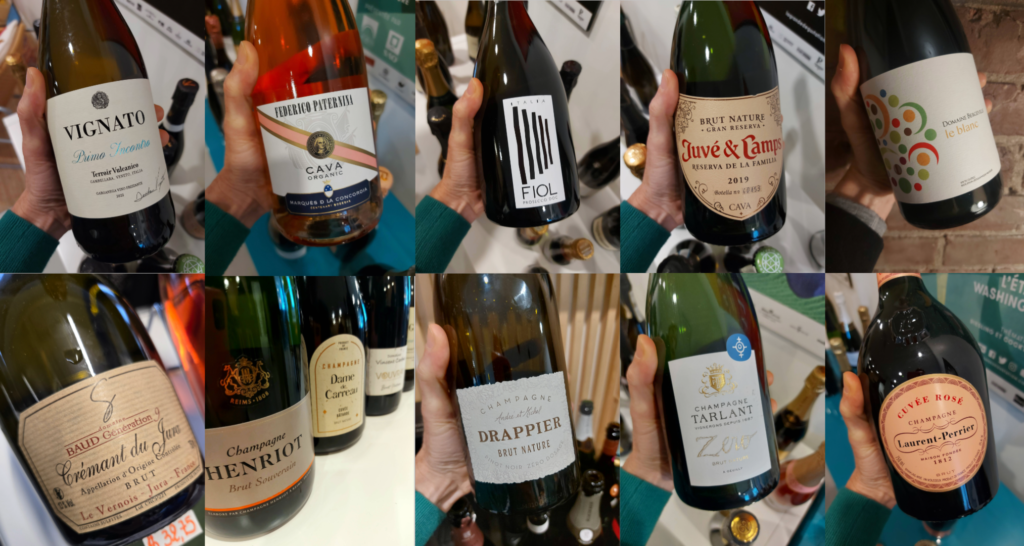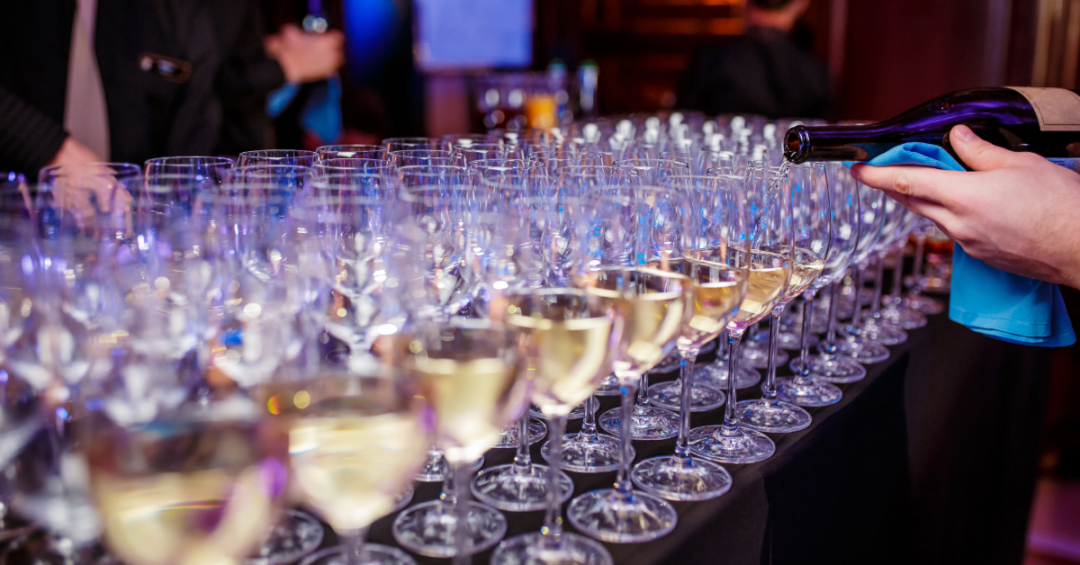How to choose sparkling wines for the holidays in 2024? Every year I get asked for my top picks. Happily, over the past couple of months, I have tasted a wide range of great sparkling wines, at all price points, for every palate preference. Check out my recommendations, tasting notes, and sparkling wine videos below.
Tis the season. Time to stock up on sparkling wines for the holidays. Festive gatherings abound this time of year and nothing sets a merrier tone that a nice bottle of fizz. They also make excellent gifts. After all, who doesn’t want a bottle of bubbly? Nobody…that is who.
Everyone’s needs are different when choosing sparkling wines for holiday gatherings – from budget-friendly options to supply big parties, to top of the line Champagnes for special occasions. And, we all have quite varied tastes. With this in mind, I have tried to make my recommendations as comprehensive as possible. There are categories for more affordable bubblies, mid-range sparkling wines , value Champagnes, and a few top drawer, premium Champagne – in everything from bone dry, to fruitier, natural to more classic styles.
Of course, there are so many other great sparkling wines out there. I would be remiss not to mention the fantastic Champagnes from Laherte, Dhondt-Grellet, and Deutz. Or, the fantastic Crémant wines from the likes of Stéphane Tissot and Domaine Pignier (Jura) or Domaine la Taille au Loups (Loire). We also have many delicious Canadian sparklings, though sadly these are not as well represented as they should be here.
But for now, the “Sparkling Wines for the Holidays 2024” list below should cover your festive feasts. Once you have made your selections, scroll to the bottom of this post for some bonus videos. A few years back, I made a series of sparkling wine videos. They offer helpful buying tips and a little education on what makes these wines so interesting. Check them out if you want to impress you friends at you next holiday gathering.
SPARKLING WINES FOR THE HOLIDAYS 2024: THE LIST.
Great Value (Under $25) Sparkling Wine for Any Occasion
Federico Paternina Cava Brut Rose 2019 – 88pts. VW (Penedès, Spain)
Pleasant aromas and flavours of crushed strawberry and rhubarb, with creamy undertones. Light and lively on the palate, with tangy red berry notes and a smooth finish. A simple, easydrinking rosé.
Where to Buy: SAQ ($17.25)
Fiol Prosecco – 89pts. VW (Veneto, Italy)
This is a clean, classic, well-made Prosecco with fine bubbles (no explosively frothy, “hamster cheek” bubbles here). Discreet aromas of spring blossoms, white pear, and anis lead into a light bodied palate with fresh, rounded acidity and a dry finish.
Where to Buy: SAQ ($18.05)
Vignato Primo Incontro Garganega Vino Frizzante – 92pts. PW (Veneto, Italy)
A natural, pét nat from the Veneto region with lots of personality for the price! Attractive earthy, sourdough bread, raw honey, and baked apricot aromas on the nose. Crisp, dry and nervy on the palate with soft bubbles, and lingering earthy/ savoury hints over tangy apple flavours.
Where to Buy: SAQ ($23.50)
Bailly Lapierre Crémant de Bourgogne Réserve – 89pts. PW (Bourgogne, France)
A smooth, crowd pleasing style of Crémant. This Pinot Noir dominant blend has charming, upfront orchard fruit and shortbread biscuit notes on the nose. The palate is fresh and broad, with big, rounded bubbles and a brut (aka fruity, rounded but not sweet) finish.
Where to Buy: SAQ ($23.85)
Juvé & Camps Reserva de la Familia Brut Nature 2019 – 91pts. PW (Penedès, Spain)
Inviting on the nose, with a nice balance of earthy, savoury, and citrussy notes, underscored by tempting hints of brioche. Crisp, medium-bodied, and layered on the mid-palate with pleasant sweet-and-sour citrus, apple notes, and a dry finish.
Where to Buy: SAQ ($24.50)
Mid-Range Sparkling Wine to Step up Your Game
Vincent Carême, Vouvray Brut 2022 (Loire, France) – 90pts. PW
Inviting nose of acacia, ripe lemon, quince, and hints of anis for this Loire Chenin Blanc bubbly. Crisp and dry on the palate, with nice tension, and quite vibrant mousse. Easy-drinking, refreshing style with a rounded, supple finish.
Where to Buy: SAQ ($27.70)
Domaine Bergeville Le Blanc Brut 2022 – 90pts. PW (Québec, Canada!)
The sparkling wine scene here at home is, well… pretty effervescent, with stand out wines from coast to coast (check out my Canadian sparkling wine article here). It is definitely worth seeking out sparkling specialists like biodynamic estate, Domaine Bergeville, who have been honing their craft for over a decade. The Blanc Brut is light, nervy, and taut with piercing, crystalline acidity, pure green fruit flavours and a dry finish – a perfect accompaniment for oysters.
Where to Buy: SAQ ($31.50)
Domaine Baud “Cuvée S” Crémant du Jura Brut – 93pts. PW (Jura, France)
A Chardonnay dominant blend, with Pinot Noir, aged for over two years on the lees. Really harmonious on the nose and palate, with pleasing notes of marzipan and ripe orchard fruit, a creamy, textural palate balanced by refreshing acidity, and smooth, persistent bubbles.
Where to Buy: SAQ ($32.75)
Vignoble des 3 Terres Mann Crémant d’Alsace Brut 2020 – 92pts. PW (Alsace, France)
This vivid, hightoned Crémant d’Alsace is made in large part with the local Pinot d’Auxerrrois grape. Initally discreet, notes of chalk and white flowers broaden to include ripe yellow apple and plum aromas with aeration. The palate is firm, yet juicy and long, with elegant, fine bubbles.
Where to Buy: SAQ ($40.25)
Affordable Luxury: Best Value Champagnes
Champagne Tarlant Zero Brut Nature – 92pts. PW
This cuvée from Tarlant is an excellent value for lovers of bone dry, zéro dosage style Champagne. Enticing gingersnap, baked apple, preserved lemon, and subtle nutty nuances on the nose. Bracing acidity sets the palate off with a zing. Offers vigorous fine mousse, lots of tension, and an austere, yet flavourful finish with lingering lemony, earthy, sourdough notes.
Where to buy: SAQ ($60.00)
Champagne Henriot Brut Souverain – 94pts. PW
The Brut Souverain from Henriot is a regular contender for best value Champagne, for my palate. An elegant, vinous bubbly with ultra fine bubbles, racy acidity, and a subtly creamy, layered mid-palate. Aromas of wet stone, brioche, hazelnut, and red apple give this quite classic appeal. Well balanced throughout, to its extra-brut finish.
Where to buy: SAQ ($63.75)
Champagne Forget-Brimont Brut Rosé Premier Cru – 93pts. PW
Pretty pale salmon in colour, this rosé Champagne has discreet aromas of elderflower, red currant and cinnamon on the nose. The palate is lithe and sleek with racy acidity, and lovely vibrancy. Finishes smooth.
Where to buy: SAQ ($63.75)
Champagne Drappier Brut Nature Pinot Noir Zéro Dosage – 92pts. PW
This Blanc de Noirs from Champagne Drappier is always an elegant option, buzzing with lively tension on the palate, in a long, vertical, bone dry style lacking austerity. Attractive red berry, white mushroom, wet stone, and ginger notes echo on the nose and palate.
Where to buy: SAQ ($65.75)
Posh Champagne to Treat your Guests (and Yourself)
Bollinger Special Cuvée Brut – 94 pts. LW
You really can’t go wrong with Bollinger’s Special Cuvée. This Brut NV offers fantastic balance of heady, indulgent flavours – shortbread, baked apple, yellow pear, with lively lemon and subtly mineral undertones. Creamy and textured on the palate, with balanced freshness, and a smooth, long finish.
Where to buy: SAQ ($97.50)
Champagne Dame de Carreau Cuvée Bâtarde 2015 – 93pts. LW
This is an interesting cuvée from a small grower Champagne house in the Côte des Bar. A blend of 60% Pinot noir, 20% Chardonnay, and 20% Pinot blanc, from 50 year old vines, grown on Kimeridgean soils (ie. the very same soils found in Chablis). The nose is quite delicate and pretty, with citrus blossom, wet stone, and white mushroom. The palate is crisp and textural, with tangy citrus, nutty, and toasty aromas, and a long, vertical finish.
Where to buy: SAQ ($109.75)
Champagne Laurent-Perrier Cuvée Brut Rosé – 93pts. LW
Medium salmon in colour, the Laurent-Perrier Brut Rosé is immediately appealing, with its vivid strawberry, raspberry, red currant, herbal, and creamy notes. The palate is broad and harmonious, with smooth bubbles, bright red fruit flavours, and a long, lifted finish.
Where to buy: SAQ ($116.50)
Egly-Ouriet Brut Grand Cru – 96pts LW
Incredibly complex and powerful, the Egly-Ouriet Brut Grand Cru is most definitely a Champagne to serve with food. This barrel aged (10% new) Pinot Noir dominant blend is made of almost 50% reserve wines, giving pleasing tertiary notes, lots of weight, and textural appeal on the palate. The nose is commanding, with chalky, mineral-focused aromas and underlying notes of green almond, apple, ripe lemon, and toasted nuances.
Where to buy: SAQ ($162)
Laurent-Perrier Grand Siècle Itération No. 26 Brut – 95pts. LW
The iconic Grand Siècle Itération No. 26 Brut from Laurent-Perrier is a blend of three exceptional vintages (2012, 2008, 2007) of Chardonnay and Pinot Noir from eight Grand Cru villages, aged 10 years on the lees, and a further few years in magnum.
The nose is incredibly elegant, with flinty, earthy intial notes, giving way to richer gingersnap, honeycomb, toasted almond, and lemon peel notes. Racy and lifted on the palate, becoming increasingly expansive to the creamy, layered core. Finishes bone dry with hints of toasty oak and savoury nuances, and a long, saline finish. Gastronimic and still quite youthful.
Where to buy: SAQ ($346.25)



